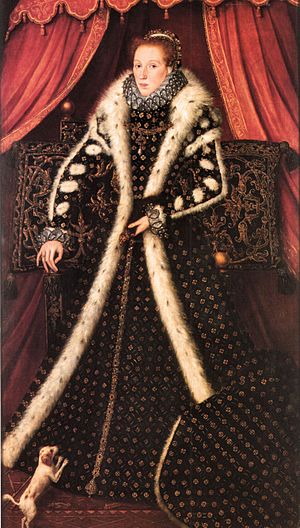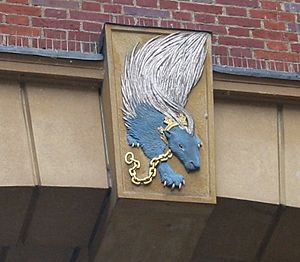Frances Sidney, Countess of Sussex facts for kids
Quick facts for kids
Lady Frances Sidney
|
|
|---|---|

The Countess of Sussex c. 1570-75, this painting hangs in the hall of Sidney Sussex College
|
|
| Born | 1531 Penshurst Palace |
| Died | 9 March 1589 Bermondsey |
| Title | Countess of Sussex |
| Tenure | 1557-1589 |
| Known for | Foundress of Sidney Sussex College, Cambridge |
| Nationality | English |
| Residence | Kilmainham Priory, Ireland; Bermondsey |
| Spouse(s) | Thomas Radclyffe, 3rd Earl of Sussex |
| Parents | Sir William Sidney and Anne Pagenham |
Frances Radclyffe, Countess of Sussex (née Sidney; 1531–1589) was an important lady in the court of Queen Elizabeth I. She is best known for founding Sidney Sussex College, Cambridge, a famous college at Cambridge University.
Frances was born in 1531 at Penshurst Place in Kent, England. Her father, Sir William Sidney, was a well-known courtier (an attendant at a royal court) during the time of King Henry VIII. Her mother was Anne Packenham. Frances was also the sister of Sir Henry Sidney and aunt to the famous poet Sir Philip Sidney.
In 1555, Frances married Thomas Radclyffe. He was known as Viscount FitzWalter at the time. He later became the 3rd Earl of Sussex in 1557. They did not have any children together.
After her death, Lady Sussex left a large sum of money to start a new college at Cambridge University. She wanted it to be called 'Lady Frances Sidney Sussex College'. Her friends and helpers made sure her wish came true, and the college was founded seven years later.
Today, Sidney Sussex College, Cambridge uses her family's coat of arms. Their mascot is a blue and gold porcupine, which comes from a special symbol of the Sidney family.
Contents
Early Life and Family
Frances Sidney was born around 1531 at Penshurst Palace in Kent. She was the youngest of four daughters born to Sir William Sidney and Anne Pagenham. She had several sisters, including Mary, Lucy, and Mabel, and a brother, Sir Henry Sidney.
Her family, the Sidneys, became very wealthy in the 1400s. They owned a lot of land in the Sussex-Surrey area. Frances's father, Sir William Sidney, was a courtier for both King Henry VII and King Henry VIII. This meant the Sidney family was well-known by the royal family.
Marriage and Life in Ireland
Frances married Thomas Radclyffe in April 1555. Their wedding was a big event, even including a jousting tournament where King Felipe (who was married to Queen Mary I of England) took part.
Thomas Radclyffe was already important in the King's court. He had been appointed to the King's special council. Frances was his second wife; his first wife had died without children. It was important for him to have an heir, so he married Frances soon after.
In 1556, Frances traveled to Ireland with her husband. He had just been made the Lord Deputy of Ireland, a very important role. However, they did not have any children. This led Lady Sussex to decide to use her wealth to support education and create a new college.
Living in Ireland
When Frances and her husband arrived in Ireland in 1556, she was 24 years old. Her husband, Lord Fitzwalter, served as the main English leader in Ireland from 1556 to 1560. He became the 3rd Earl of Sussex in 1557, making Frances the Countess of Sussex.

They were supposed to live in Dublin Castle, but it was in very bad shape. So, they lived instead at the priory of Kilmainham, a property outside Dublin that had been fixed up. They stayed there until Dublin Castle was later renovated.
The Earl and Lady Sussex spent a lot of time away from Ireland. They often spent half the year in Ireland and the other half in England. This made it hard for them to form strong connections with the Irish people.
Diplomatic Relations
Lady Sidney's husband, the Earl of Sussex, was known for his military leadership. He formed a good relationship with Sean Maguire, a powerful Irish leader. Maguire even gave Lady Sidney two of his best hawks as a gift. This was a symbolic gesture of friendship between them.
Another Irish leader, Shane O’Neill, wanted to be recognized as the Earl of Tyrone. After some conflict, O’Neill won and was recognized. He then even asked Queen Elizabeth I if he could marry Lady Frances Radclyffe, the Earl of Sussex's sister.
At the Court of Queen Elizabeth I
Frances Sidney did not have a role in the courts of earlier monarchs like Edward VI or Mary I. However, in 1571, she became a favorite of Queen Elizabeth I. This was partly because her sister-in-law, Mary, was a chambermaid to the Queen.
Queen Elizabeth visited the Earl and Countess of Sussex at their home in Bermondsey twice in 1571. That year, both Mary and Frances caught smallpox. Mary was badly scarred, but the Queen and Frances recovered well. In 1578, Lady Sussex was officially appointed as a lady of the Queen's chamber.
The Earl of Sussex and the Earl of Leicester were known rivals for the Queen's favor. Before he died, the Earl of Sussex warned Frances about the Earl of Leicester, saying he would be difficult. Their marriage faced problems due to outside interference. Lady Sidney wrote to the Queen, explaining that external forces had damaged their "love of twenty-eight years."
Death and Legacy
The Earl of Sussex died in June 1583. In his will, he left Frances many valuable items, including jewels and silver, and income from his estates.
After her husband's death, Lady Sidney became very focused on Protestantism. She managed her inherited estates wisely and became quite wealthy. She died at her home in Bermondsey on March 9, 1589, and was buried in Westminster Abbey.
Founding Sidney Sussex College, Cambridge
Lady Sidney was always very passionate about education. In her will, dated December 6, 1588, she stated her wish to use the money she inherited to "erect some good and godly monument for the maintenance of good learning."
She left £5,000 to build and establish a new college at the University of Cambridge. She wanted it to be called "Lady Frances Sidney Sussex College." This money was enough to support a master, ten fellows (teachers), and twenty scholars (students).
Her helpers, the Earl of Kent and Sir John Harrington, worked hard to set up the college. If there wasn't enough money, Lady Sidney had also said the funds could go to improve an existing college, Clare College, Cambridge. In that case, it would have been renamed "Clare and Lady Frances Sidney Sussex College."
Even though some of Lady Sidney's relatives tried to challenge her will, they were not successful. The college was officially founded in 1596, seven years after her death. Queen Elizabeth I herself helped make sure it happened.
A porcupine, a symbol from her family, appears on her large monument in Westminster Abbey. This monument shows her wearing the special crown of a countess.
Images for kids
-
Clare College, Cambridge, the college which would have received Lady Sidney's inheritance but for the persistence of her executors.






